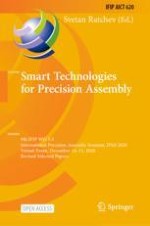1 Introduction
-
We substantiate the usability of learning-based pose estimators trained using only synthetic depth data for challenging, industrially relevant, texture-less objects.
-
We provide guidelines to train Convolutional Neural Networks (CNN) for pose estimation of objects with rotational symmetries or one plane of symmetry.
2 Related Work
3 Approach
3.1 Network Architecture
3.2 Symmetry Handling
4 Experiments
4.1 Network Training
4.2 Evaluation Metrics
4.3 Results
Object | Sundermeyer et al. [6] | SyDPose | SyDPose + ICP |
|---|---|---|---|
1 | 8.87 | 5.13 | 15.81 |
2 | 13.22 | 7.00 | 23.56 |
3 | 12.47 | 12.22 | 19.44 |
4 | 6.56 | 5.25 | 14.68 |
5 | 34.8 | 13.65 | 30.65 |
6 | 20.24 | 5.33 | 13.29 |
7 | 16.21 | 1.40 | 8.81 |
8 | 19.74 | 0.26 | 5.16 |
9 | 36.21 | 3.40 | 10.28 |
10 | 11.55 | 4.68 | 18.72 |
11 | 6.31 | 1.19 | 12.17 |
12 | 8.15 | 4.17 | 19.51 |
13 | 4.91 | 7.47 | 9.72 |
14 | 4.61 | 9.02 | 18.32 |
15 | 26.71 | 6.19 | 30.56 |
16 | 21.73 | 13.40 | 31.75 |
17 | 64.84 | 1.29 | 16.14 |
18 | 14.3 | 3.54 | 18.72 |
19 | 22.46 | 4.00 | 10.17 |
20 | 5.27 | 3.20 | 12.55 |
21 | 17.93 | 3.86 | 16.87 |
22 | 18.63 | 2.84 | 15.61 |
23 | 18.63 | 2.00 | 18.01 |
24 | 4.23 | 6.98 | 26.19 |
25 | 18.76 | 4.51 | 34.03 |
26 | 12.62 | 3.40 | 24.80 |
28 | 23.07 | 1.33 | 15.34 |
29 | 26.65 | 2.46 | 31.25 |
30 | 29.58 | 6.99 | 44.44 |
Mean | 18.25 | 5.04 | 19.54 |
